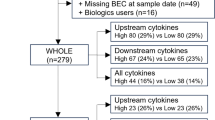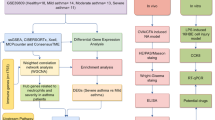Abstract
Background
Corticosteroids (CSs) are the preferred anti-inflammatory therapy for the treatment of asthma, but the responses of asthmatics to CSs are known to vary. It has thus become important to discover reliable markers in predicting responses to CSs.
Methods
We performed time-series microarrays using a murine model of asthma after a single dose of dexamethasone, based on the assumption that the gene showing a greater change in response to CSs can also be a potential marker for that finding. We then evaluated the clinical meaning of the gene discovered in the microarray experiments.
Results
We found that the expression of FK506 binding protein 51 gene (FKBP51) in lung tissue markedly increased after dexamethasone treatment in a murine model of asthma. We then measured dexamethasone-induced FKBP51 expression in peripheral blood mononuclear cells (PBMCs) in asthmatics. Dexamethasone-induced FKBP51 expression in PBMCs was significantly higher in severe asthmatics compared with mild-to-moderate asthmatics treated with inhaled CSs. In addition, we found that dexamethasone-induced FKBP51 expression in PBMCs was inversely correlated with improvement in lung function after treatment with orally administered prednisolone in six steroid-naive asthmatics.
Conclusion
Dexamethasone-induced FKBP51 expression in PBMCs may be a reliable and practical biomarker in predicting the response to CSs in asthmatics.



Similar content being viewed by others
Abbreviations
- CSs:
-
Corticosteroids
- FKBP51:
-
FK506 binding protein 51
- GR:
-
Glucocorticoid receptor
- PBMCs:
-
Peripheral blood mononuclear cells
- PBS:
-
Phosphate-buffered saline
References
National Asthma Education and Prevention Program (2007) Guidelines for the diagnosis and management of asthma: Expert Panel Report 2. Publication #08-4051. Bethesda (MD): National Institutes of Health/National Heart, Lung, and Blood Institute
Bateman ED, Hurd SS, Barnes PJ, et al. Global strategy for asthma management and prevention: GINA executive summary. Eur Respir J. 2008;31:143–78.
Malmstrom K, Rodriguez-Gomez G, Guerra J, et al. Oral montelukast, inhaled beclomethasone, and placebo for chronic asthma: a randomized, controlled trial. Montelukast/Beclomethasone Study Group. Ann Intern Med. 1999;130:487–95.
Kerrebijn KF, van Essen-Zandvliet EE, Neijens HJ. Effect of long-term treatment with inhaled corticosteroids and beta-agonists on the bronchial responsiveness in children with asthma. J Allergy Clin Immunol. 1987;79:653–9.
Szefler SJ, Martin RJ, King TS, et al. Significant variability in response to inhaled corticosteroids for persistent asthma. J Allergy Clin Immunol. 2002;109:410–8.
Martin RJ, Szefler SJ, King TS, et al. The predicting response to inhaled corticosteroid efficacy (PRICE) trial. J Allergy Clin Immunol. 2007;119:73–80.
Smith AD, Cowan JO, Brassett KP, et al. Exhaled nitric oxide: a predictor of steroid response. Am J Respir Crit Care Med. 2005;172:453–9.
Boulet LP, Becker A, Be’rube’ D, et al. Canadian asthma consensus report. Can Med Assoc J. 1999;161(Suppl11):S1–62.
Ungar WJ, Champman KR, Santos MT. Assessment of a medication-based asthma index for population research. Am J Respir Crit Care Med. 2002;165:190–4.
Vermeer H, Hendriks-Stegeman BI, Verrijn Stuart AA, et al. A comparison of in vitro bioassays to determine cellular glucocorticoid sensitivity. Eur J Endocrinol. 2004;150:41–7.
Vermeer H, Hendriks-Stegeman BI, van der Burg B, et al. Glucocorticoid-induced increase in lymphocytic FKBP51 messenger ribonucleic acid expression: a potential marker for glucocorticoid sensitivity, potency, and bioavailability. J Clin Endocrinol Metab. 2003;88:277–84.
Vermeer H, Hendriks-Stegeman BI, van Suylekom D, et al. An in vitro bioassay to determine individual sensitivity to glucocorticoids: induction of FKBP51 mRNA in peripheral blood mononuclear cells. Mol Cell Endocrinol. 2004;218:49–55.
Davies TH, Ning YM, Sánchez ER. A new first step in activation of steroid receptors: hormone-induced switching of FKBP51 and FKBP52 immunophilins. J Biol Chem. 2002;277:4597–600.
Wochnik GM, Ruegg J, Abel GA, et al. FK506-binding proteins 51 and 52 differentially regulate dynein interaction and nuclear translocation of the glucocorticoid receptor in mammalian cells. J Biol Chem. 2005;280:4609–16.
Denny WB, Valentine DL, Reynolds PD, et al. Squirrel monkey immunophilin FKBP51 is a potent inhibitor of glucocorticoid receptor binding. Endocrinology. 2000;141:4107–13.
Denny WB, Prapapanich V, Smith DF, et al. Structure-function analysis of squirrel monkey FK506-binding protein 51, a potent inhibitor of glucocorticoid receptor activity. Endocrinology. 2005;146:3194–01.
Woodruff PG, Boushey HA, Dolganov GM, et al. Genome-wide profiling identifies epithelial cell genes associated with asthma and with treatment response to corticosteroids. Proc Natl Acad Sci USA. 2007;104:15858–63.
Ito K, Chung KF, Adcock IM. Update on glucocorticoid action and resistance. J Allergy Clin Immunol. 2006;117:522–43.
Drazen JM, Silverman EK, Lee TH. Heterogeneity of therapeutic responses in asthma. Br Med Bull. 2000;56:1054–70.
Pavord ID, Brightling CE, Woltmann G, et al. Non-eosinophilic corticosteroid unresponsive asthma. Lancet. 1999;353:2213–4.
Haldar P, Brightling CE, Hargadon B, et al. Mepolizumab and exacerbations of refractory eosinophilic asthma. N Engl J Med. 2009;360:973–84.
Adcock IM, Barnes PJ. Molecular mechanisms of corticosteroid resistance. Chest. 2008;134:394–401.
McKeen HD, McAlpine K, Valentine A, et al. A novel FK506-like binding protein interacts with the glucocorticoid receptor and regulates steroid receptor signaling. Endocrinology. 2008;149:5724–34.
Reynolds PD, Ruan Y, Smith DF, et al. Glucocorticoid resistance in the squirrel monkey is associated with overexpression of the immunophilin FKBP51. J Clin Endocrinol Metab. 1999;84:663–9.
Baptist AP, Reddy RC. Inhaled corticosteroids for asthma: are they all the same? J Clin Pharm Ther. 2009;34:1–12.
Motsinger AA, Ritchie MD, Reif DM. Novel methods for detecting epistasis in pharmacogenomics studies. Pharmacogenomics. 2007;8:1229–41.
Wilke RA, Reif DM, Moore JH. Combinatorial pharmacogenetics. Nat Rev Drug Discov. 2005;4:911–8.
Acknowledgements
This work was supported by a grant from the Korea Health 21 R&D Project (AO30001) from the Ministry of Health and Welfare, Republic of Korea, and by a grant from Seoul National University Hospital (0420071030).
Author information
Authors and Affiliations
Corresponding author
Electronic supplementary material
Below is the link to the electronic supplementary material.
ESM 1
(PDF 205 kb)
Rights and permissions
About this article
Cite this article
Chun, E., Lee, HS., Bang, BR. et al. Dexamethasone-Induced FKBP51 Expression in Peripheral Blood Mononuclear Cells Could Play a Role in Predicting the Response of Asthmatics to Treatment with Corticosteroids. J Clin Immunol 31, 122–127 (2011). https://doi.org/10.1007/s10875-010-9463-9
Received:
Accepted:
Published:
Issue Date:
DOI: https://doi.org/10.1007/s10875-010-9463-9




